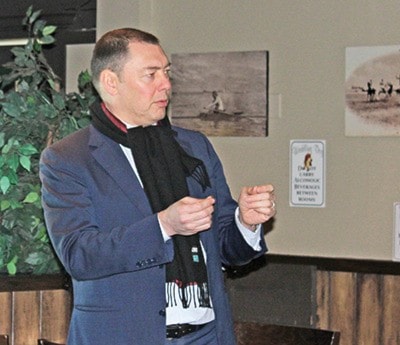Liquified natural gas, or LNG, facilities are not new to the province — or even Vancouver Island, says Alex Brigden.
Brigden is the project director for the proposed Malahat LNG facility being floated by Steelhead LNG, the company working with the Malahat First Nation on the plan.
Brigden and Steelhead LNG CEO Nigel Kuzemko presented information about the project to a small crowd at the Quality Inn Waddling Dog in Central Saanich Feb. 17, hosted by the Saanich Peninsula Chamber of Commerce.
“Let’s understand that LNG and LNG production is not new to B.C and the reason we are proposing an LNG plant to be able to get the product to the far east is because you can’t put a pipeline all the way across the pacific.”
He added an LNG plant liquifies the product, enabling it to be transported via ship to markets in places such as northern Asia.
So why the Bamberton site?
One of the key reasons is access to deepwater port facilities. Saanich Inlet is very steep sided, he said, meaning that would require building jetties to accommodate LNG transport vessels. The jetties proposed, he said, are very short with no dredging of the inlet required. An existing landing area at the site, he continued, is ideal for LNG shipping.
Brigden said the site is very close to international shipping lanes, where there are around 10,000 vessels moving through the Juan de Fuca Strait between Vancouver, the U.S. and other international ports.
The Bamberton site itself, he added, has been industrialized for about 100 years.
“So we’re not taking a green field site and [proposing] an LNG plant like some of the proponents are up north.”
Steelhead LNG is currently only starting their engineering studies and are calling this the concept phase. They have looked at several different layouts, all of which are floating facilities.
During the discussion, the public had the opportunity to ask questions. When asked about accoident potential, Brigden replied there has never been an incident leading to loss of containment in the cargo tanks of an LNG carrier.
“Firstly, LNG carriers have a lot of passive protection inherent in the design. The key feature here is a double hull ...” said Brigden.
Adam Olsen, former leader of the B.C. Green Party and a former Central Saanich municipal councillor, asked where this project stands in terms of the interests of First Nations outside of the company’s deal with the Malahat First Nation.
Brigden said the company has not yet completed ongoing heritage or socio-economic studies. They are also engaging with First Nations to understand title and treaty rights.
Mark Loria of the Centre for the Salish Sea had a few concerns with the project.
“You’re really looking at the entire Salish Sea here, there’s 20 First Nations (in the region),” Loria stated. “It seems a bit surprising to me that you mentioned one nation where you’re located but you’re actually going through the Salish Sea.”
Loria added that his concerns are with a proposed underwater pipeline and the potential for leaks. His other concern was of big ship movements.
“It seems really surprising to me that you would come into the Saanich Inlet with such a big boat, with such floating devices in such a small area.”
Sylvia Olsen, a member of the Tsartlip First Nation, said her concern was with consultation, stating she hasn’t heard about what’s going to be good for First Nations in this project.
Kuzemko said the company will have to consult with many more people for a better understanding.
On Oct. 2, 2015 Steelhead LNG announced National Energy Board approval for a license to export up to 30 million tonnes of liquified natural gas per year over a 25-year period from two proposed sites.
Steelhead had previously announced proposals to build export facilities on each Vancouver Island coast: a $30 billion facility at Sarita Bay, about 75 kilometres southwest of Port Alberni, and a smaller floating terminal at the Bamberton site just south of the Mill Bay ferry terminal.
The Sarita Bay proposal is being explored with the Huu-ay-aht First Nation, while the Mill Bay project is proceeding in conjunction with the Malahat First Nation.
The latter band received a jolt earlier this month with the announcement three top economic development officials had been dismissed as part of an ongoing review of governance and finances initiated by new Chief Caroline Harry and her council shortly after they were elected in November.
Previous chief Michael Harry resigned last summer amidst allegations he was receiving a consulting fee from the owners of a controversial contaminated soil treatment facility near Shawnigan Lake.
Kuzemko said Steelhead is continuing to work with the new chief and council to iron out any concerns they may have.
“Every organization goes through this, particularly after a political change,” he said. “The deal that we signed is still in place.”
The Mill Bay plant has come under fire from some neighbours around Saanich Inlet, who say it comes with too much environmental risk. The Cowichan Valley Regional District last week formalized its opposition due to those environmental concerns.
“We should make it clear that the Cowichan Valley, or anywhere else in B.C. for that matter, is not the place for this kind of project,” Shawinigan Lake Director Sonia Furstenau said.
— with files from John McKinley/Black Press
